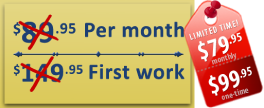Control your debt so it doesn't control you
TweetSteps to becoming debt-free
There are many facets to the debt phenomenon. Enormous student loans, medical emergencies, reckless spending, shopping sprees; these are only some of the scenarios for increasing consumer debt. Fortunately, there are many measures that can be taken to relieve the pressure of mounting debt. Applying even one of the five following steps will improve your situation; naturally, the more measures you implement, the greater the relief.
Stop creating debt
Do not open any new accounts and don't use your existing ones unless you have the cash to pay off your balances every month. You must get out of the habit of swiping your card whenever it comes time to make a purchase. One strategy to help break the habit is a "cooling-off period". Remove all credit cards from your wallet and put them in a place that is not easily accessible, like a safe-deposit box. Estimate your everyday spending for the week and have that much cash on hand. When you have a pre-set limit as to how much you can spend, you will scrutinize your purchases more closely. If you just don't feel comfortable without cards in your wallet, then keep only two in case of emergency, and remove the rest. Choose to keep the ones that have rewards associated with them or the lowest interest rate, but do your best to pay them off every month.
Spend less than you earn
Sounds simple enough, but with the increasing availability of credit, people often forget how much they actually make and focus more on their available credit. By implementing step one and using cash for purchases, you will be better equipped to stay within your means. You need to create positive cash flow in order to alleviate debt.
Increase consciousness of how and where you spend your money
In other words, create and stick to a budget. Many people are resistant to creating a budget because they are afraid that they will fail or that they will feel restricted. The word budget can carry a negative connotation; so re-name it "spending plan". Think of it as a guideline to ensure that you will have enough money for the things that are most important to you and your family. Establish how much you are bringing in and keep a detailed list of how much is going out. See where you can re-allocate funds to create more financial freedom in the future.
Set financial goals
Goal-setting is critical to achieving anything of significance, particularly getting out of debt. The task can seem daunting, but you will be much better off having a plan, both short-term and long-term. A short-term plan would be to pay off your lowest account balance first by paying more than the monthly minimum. Yes, it is wiser to focus on the highest APRs first, but if you can quickly get rid of at least one extra payment a month, it will boost your confidence to tackle other ones. Once you have paid off one or two of your lowest balances, switch to the highest APR and then apply the previous payment(s) to that account. You are creating that light at the end of the tunnel to focus on as you continue to make those monthly payments. Set a long-term goal of what you plan on doing with the money that no longer goes toward credit card balances.
Pay your bills on time every month
Using the strategy in the previous paragraph, you are tackling one account at a time. That doesn't mean you neglect to pay your other bills. Added interest charges, late fees, and damage to your credit report will cancel out any paid in full balances. Late payments are catastrophic to your credit; even one could lower your score by 100 points or more. Do everything in your power to pay all bills on time every month.



